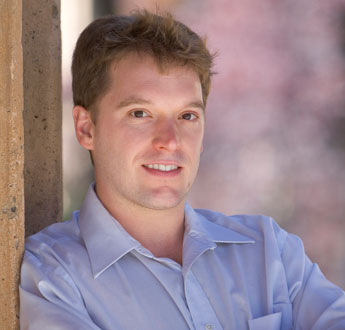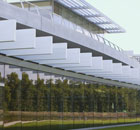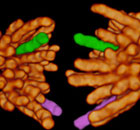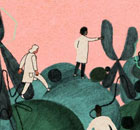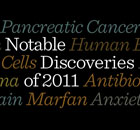Q&A: Mooney and Looger on the Janelia Conference Experience
The Janelia Farm conference program is as singular as the place itself. Intentionally focused and intimate, the dozen or so conferences hosted at Janelia every year are designed as much for conversation as for presentation. In this Q & A, two scientists—Janelia group leader Loren Looger and Duke University neurobiologist Richard Mooney—share their thoughts on a conference experience like no other.
Looger: An Organizer’s Perspective
Loren Looger is a chemist who engineers proteins to use as tools. He’s devised neurotransmitter detectors, improved labels for imaging, designed receptors, and rewired neural circuits—all for studying the brain. Looger has helped organize several Janelia-sponsored conferences, including a November 2010 conference on “Genetic Manipulation of Neuronal Activity,” which he organized with fellow Janelia group leaders Julie Simpson and Scott Sternson.
Q: How is the Janelia conference program unique?
A: Both the breadth and depth of topics are above average. The huge conferences, like the Society for Neuroscience or Protein Society conference, are all networking. They are just too big to have any efficient information transfer. Resulting collaborations are probably zero, or close to zero. I can trace five of my 10 most recent papers to ideas, conversations, or collaborations that came about at Janelia conferences.
Q: What’s it like working at the site of a conference and having people come to you?
A: Before I came to Janelia, I only occasionally went to conferences, and most were in my field of protein design. Being in the interdisciplinary pressure cooker here made me raise my game; I attend a lot of Janelia conferences that aren’t relevant to my work on the surface, but usually there’s a connection to be found somewhere. Some people like to say that our conferences are so good that most of us won’t need to go to other conferences very much. And it’s true, in our fields most of the best people come to us two or three times a year.
Q: How important is it to limit the size of a conference at Janelia?
A: For the first conference I organized, I invited 71 people and 68 said yes. That’s big for Janelia; half of our conferences have around 30 participants. The small scale leaves lots of room in the agenda for discussion. At the big conferences, you barely get one or two questions in after a talk, and then the next person’s up.
Here we actually have the time and freedom to pursue some unconventional things between talks. For example, one of our conferences had a “speed dating” event during one of the social hours; they stuck each PI at a table and then the postdocs and students got four minutes with each one, before a bell rang and they had to move on. Where else can you get that opportunity?
Q: Can you give an example of how an experience at a Janelia conference affected your work?
A: There are many. At one conference, Ron Yu from the Stowers Institute mentioned in a talk that there are companies that sell urine from any animal you want. Their market is mainly farmers who want to scare animals away from their crops. Yu was imaging the mouse brain and had ordered coyote pee; the mouse smells it and all these cells light up with a sensor that we developed in our lab.
The mouse has evolved ways to not be eaten by the coyote. But Yu is a biologist, not a chemist. He wanted to know what was in the urine that was setting off the mouse brain. I went up to him and said “we can help you figure this out.”
Mooney: An Outsider’s Perspective
Richard Mooney is director of graduate studies for the Duke University Program in Neurobiology and George Barth Geller Professor of Research and Neurobiology. His lab is dedicated to studying the biological basis of learning, memory, and communication in songbirds. In March, he attended a Janelia Farm conference organized in part by group leader Roian Egnor, “Producing and Perceiving Complex Acoustic Signals: Songbirds and Mice as Model Systems.”
Q: What is the nature of your work?
A: Our interests are broad, but they focus on learning and memory from the angle of auditory experience—how hearing influences the development of vocalization. We primarily use songbirds as a model system because they imitate their elders, a fairly rare instance of that kind of learning with very strong parallels to human speech learning. We can ask how the system goes from naive, to memorization, to a state of mastery of vocalization.
Q: Other than the obvious relevance to your research, what drew you to this conference?
A: I had been to one other conference at Janelia in 2010. It left me with an extremely positive impression, not just of the conference program but of the place itself. It’s a beautiful campus, and the scale of the meeting is just right because attendance is limited. I think that’s tremendous; I avoid meetings that are particularly large because they end up being mostly social affairs.
With a smaller conference, you can focus on the science first and foremost. The only other conference program I can think of that compares is the Gordon Conference.
Q: Did you have opportunities for meaningful conversations and to meet potential collaborators?
A: Yes. Because everyone stays on campus, you’re in quarters all the time with meeting attendees. You can go from a more formal setting where someone is presenting data to a few minutes later, hanging out at the pub. The most interesting questions after a talk percolate up into consciousness more slowly, and this structure allows you to ask those questions after the formal session is over.
There’s also the fact that if you commit to coming, you commit to come for the whole meeting. At other conferences, people often come for the day they are scheduled to speak, or the day that the presentations are most closely related to their own work, and then they leave. So the meeting has this uneven quality to it, and you never know if you’ll be able to catch up with someone or not. Because Janelia covers all your costs once you get there, the stipulation is you have to stay. Everybody wants to anyway.
Q: Is there a benefit to attending a conference at a research facility rather than a traditional conference venue?
A: There are really great scientists at Janelia, and often they participate in the meetings. You’re at a place where science is getting done. Cold Spring Harbor and Woods Hole also have this quality, but it’s rare. It gives the whole thing a sense of immediacy and vibrancy.
If I know someone at Janelia or I’m interested in their work, I can drop in their lab and see what they’re up to. Seeing science happening is always better than just hearing about it. At a Janelia conference you get both.
